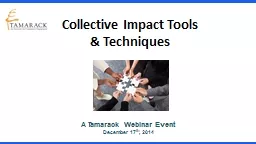

amp Techniques A Tamarack Webinar Event December 17 th 2014 Visuals If you can see this slide please raise your hand in the GoToWebinar control panel Audio Options VoIP You may choose to connect your audio using your computers speakers A headset is recommended ID: 589527
Download Presentation The PPT/PDF document "Collective Impact Tools" is the property of its rightful owner. Permission is granted to download and print the materials on this web site for personal, non-commercial use only, and to display it on your personal computer provided you do not modify the materials and that you retain all copyright notices contained in the materials. By downloading content from our website, you accept the terms of this agreement.
Slide1
Collective Impact Tools & Techniques
A Tamarack Webinar EventDecember 17th, 2014Slide2
Visuals:
If you can see this slide please raise your hand in the GoToWebinar control panelAudio Options:VoIP: You may choose to connect your audio using your computer’s speakers. A headset is recommended.Phone: You may choose to call in using your telephone Enter the unique audio pin you see in the audio tab of your GoToWebinar control panelTech Support: Use Question/Chat box
in your GoTo Webinar control panel or email Kirsti@tamarackcommunity.ca.Twitter:
For those of you who like to tweet your thoughts as you learn – we invite you to use the hashtag - #
tamarackconnect
. Questions? Please use the question/chat box.
Technical ConsiderationsSlide3
Kirby EdmondsDCI Senior Fellow and Program CoordinatorTFC Associates
Our Guest PresentersTom KlausPrincipal, Tom Klaus & AssociatesRuss GaskinManaging Director, CoCreative ConsultingSlide4
Roots to Fruit of Sustainable Community ChangePresented by Tom KlausSlide5
About the R2F Framework
Integrated model for facilitating long-term community change Operationalized and tested in a “nested” backbone configuration: funder > statewide “primary backbone” > 19 local community “backbone coalitions” Framework identifies internal and external processes in play that facilitate long-term community changeSlide6
Internal processes (“roots”): Related to establishing a high performing local coalition backbones
External processes (“fruit): Successfully facilitated by a high performing coaltion to bring about policy, practice, social attitude and behavioral changes in community that “stick” for a long time First wave of annual evaluation to be conducted in early 2015Slide7
R2F ToolsSelf-Assessment (Currently available free upon request)Currently used by community coalitions to assess their progress in both coalition development and community engagement progress
R2F Tailored Implementation Instruction and Training (January, 2015) R2F framework presented as a “min specs” approach to community transitionTailored instruction focused on helping sites develop strategies and tactics for use in their unique communities and situations Slide8
R2F ToolsOnline Evaluation Survey (available by Spring 2015 in conjunction with R2F training and instruction)
Online survey completed by individual members of the coalition backbones – individual people, not organizationsEight scales – related to the major processes in the R2F frameworkScales have been shown to have strong reliability in pilot testsIndividual measures within scales have similarly been shown to have strong face validityFor more information about the R2F framework or any of these tools, contact: Tom Klaus, Ph.D.twklaus@nonprofitgp.comPhone: 240-319-8525Slide9
Problem Identification ToolPresented by Kirby EdmondsSlide10
Problem Identification ToolChangeable
Going WellGoing PoorlyFIRmOr FIxEdAssets
Needs Maintenance
Constraints/Disasters
ProblemsSlide11
Sorting the ProblemsFast Way-Dots or show of handsMore deliberative:
Use criteria such as:ImportanceUrgencyCostDifficultySlide12
AdvantagesSimple self-assessmentFlexible in terms of nature of issues
(simple to complex)Flexible in terms of time required (1-3 hours or 1-2 days)EngagingTurns attention to what can be changedEstablishes priorities for improvementSlide13
The Key Initiator ApproachPresented by Russ GaskinSlide14
Key Initiator Examples
Community Capital to move $1 billion in new capital to U.S. CDFI’s (3X success) Market differentiation at no costSolar Circle to bring U.S. cost of solar to 50% of supply by 2050 (on track for 2025) Policy, industry coordination, research, new venturesBetter Paper to transition U.S. magazine industry to recycled paper (150+ titles) Best practices, myth-busting, research, testing
Impacting Poverty
to
move 5 million Americans out of
povertyThe Southern
Initiative to revitalize South Auckland, New Zealand
Non-GMO Supply Working Group
return non-GMO corn and soy to market dominance
Clean
Electronics Production
to
eliminate toxic exposures
in
electronics
manufacturing
Utility
of the
Future
create the US’s first
vertically-integrated 100% renewable energy utility.
+1-202-525-6070 |
russ@cocreativeconsulting.comSlide15
Key Initiator Situations
The problem is chronic and previous attempts to solve it have failedStakeholders have divergent worldviews and frames for defining the problemThe system is complex and no one person has a view on the whole problemThe system is fragmented and there is a distinct lack of communication and coordination among the partsThe system is paradoxically dynamic yet stuck and while the influence of various actors shifts over time, there is no meaningful movementThere is some level of anticipation among SOME stakeholders that new, more integrated solutions could emerge
+1-202-525-6070 | russ@cocreativeconsulting.comSlide16
Key Initiator Qualities
CharacteristicPolarityHeld in high regard by their peersHumility & ConfidenceHigh expertise in their part of the system/value chainExpertise & Ignorance
Proven collaboration abilities
Self-interest & Common good
Willingness to really
understand the issues/system,
and courage to act quickly on that understanding
Analytical & Action-oriented
Able to represent their institution’s involvement
Individual interests & Institutional interests
90% of participants are 100% committed to the goal; 10% are skeptics but open to evidence-based learning
Commitment & Skepticism
+1-202-525-6070 |
russ@cocreativeconsulting.comSlide17
Key Initiator Principles
(Based on the work of Susan Davis)“A deal is a good deal when it is good for all concerned”
Each
member does what s/he loves to do, does uniquely
well,
and does as little
else as possible
Build trust, build collective intelligence, and build momentum
Analyze fast, prototype early, and learn with our hands
Everything
is a hypothesis, even our goal
Differentiate
before we integrate
Leverage
tensions
+1-202-525-6070 |
russ@cocreativeconsulting.comSlide18
Comments or Questions?Slide19Slide20